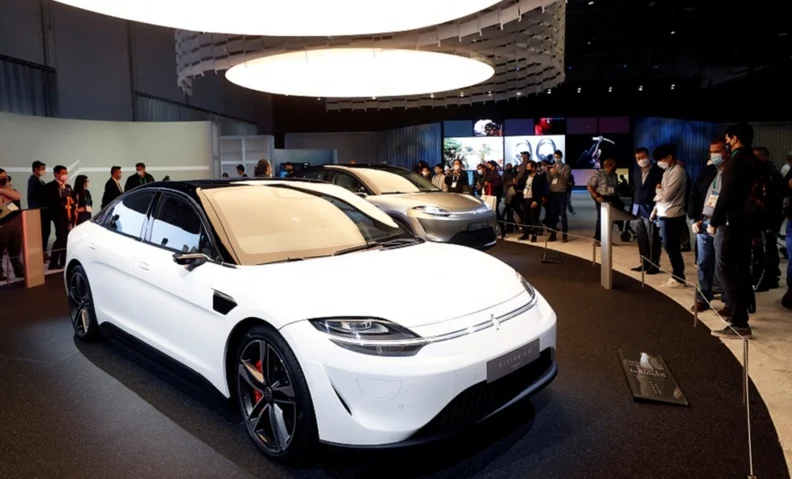Sony Honda set to make premium EVs in North America from 2025
Honda and Japanese electronics giant Sony have announced they are planning to produce their new jointly developed EV at a Honda plant in North America and deliver it first to U.S. customers in 2026.
Sony Honda Mobility also plans to export the EV to Japan from North America. A launch for Europe is also being considered, but no plan has been set.
Executives described the upcoming EV as a high value-added model that will build-in lots of new technology from Sony, including entertainment systems, advanced software and loads of sensors.
Retailing will be centered around online sales, following Honda’s dabbling with that model in Japan. Various aftermarket and service plans are still under consideration, Honda said.
The rollout prioritizes North America, one of Honda’s most important markets, because the U.S. is advancing quickly in electric vehicle development and market acceptance.
EV-friendly incentives and regulations, like those in California, also played a role.
“The reason we chose North America is because it is more advanced,” Yasuhide Mizuno, CEO of the new joint venture company, said while announced the timeline at a Thursday briefing.
“I think North America is a market with a lot of purchasing power,” he said. “Electrification varies from state to state, but it is important for us to release our product in markets like California.”
Sony Honda Mobility is not ruling out production in Japan someday. But for now, North America will be the main production and sales base.
Deliveries in Honda’s home market will begin in the second half of the 2026, making the new EV a rare American-made export shipped to Japan, by a Japanese brand.
Sony Honda Mobility will start taking orders for the new car in the first half of 2025.
The tie-up is the first major collaboration between two iconic Japanese brands from different industries to tackle the challenges of new mobility in an auto industry under siege by change. By harnessing the strengths of two powerhouses, it could be an effective riposte to interloping outsiders such as Tesla or Apple, which have not yet reached cross-industry in such a formal way.
“We would like to form this company as a whole new automaker completely different from anything else,” Mizuno said at the Tokyo briefing. “Our goal is not to become an ordinary car manufacturer, but to become a new mobility tech company centered on software technology.”
The new joint venture teased a video of a mock-up or concept of the upcoming car, hinting it would be shown Jan. 4 at the Consumer Electronics Show in Las Vegas. But Mizuno declined to detail specifics of the new vehicle – including targeted sales volume, pricing and body style.
“A high value-added product is what we are looking at, so it’s not like we’re looking at mass production,” Mizuno said. But he equated “high value-added” to top-tier offerings such as the Honda Legend premium sedan, which has a Level 3 autonomous driving system in Japan.
Honda will be responsible for manufacturing and procurement, he said. But Mizuno would not say what assembly plant would make the vehicle or who would supply the battery. The project will leverage Honda’s existing supply chain, and current battery partners including LG and General Motors, which has a propriety battery system called Ultium, are under consideration, he said.
EV ambitions
The news from Tokyo comes after Honda’s announcement in the U.S. that it would create an electric-vehicle production hub in Ohio as it doubles down on an all-electric future.
Those plans include building a battery plant with its South Korean partner LG at a cost of $3.5 billion and spending an additional $700 million to retool three plants in the state to make EVs.
Based in Tokyo, the 50-50 joint venture between Sony and Honda was announced earlier this year. Izumi Kawanishi, a Sony executive vice president, is its COO. Mizuno comes from Honda.
The partners say Sony Honda Mobility will combine Honda’s expertise in engineering and manufacturing vehicles, along with its proficiency in providing after-sales service, with Sony’s strengths in imaging, sensing, telecommunications and entertainment.
Honda, in the midst of a radical corporate makeover, said in April it will invest 5 trillion yen ($37.16 billion) over the next 10 years in electrification as it rolls out 30 full electric vehicles globally and builds production capacity for 2 million EVs annually by 2030.
Honda wants to drop combustion and shift to pure electric drivetrains by 2040.
In detailing the strategy, Honda said it will also shift its business away from non-recurring hardware sales toward recurring sales of services that combine hardware and software.
It is part of new software-defined EV platform, dubbed e:Architecture, that the company will launch in 2026 to underpin the next generation of large-sized battery electric cars from Honda.
Honda expects to be ready to supply 800,000 EVs to North America by 2030.
Sony will be responsible for much of the car’s cloud-based systems, electronics, software and infotainment, as well as sensors that help deliver higher levels of automated driving.
Kawanishi dangled Sony’s mammoth library of movies, music and photos as a wealth of content that could be served up on the go. Automated driving will make automobiles a more viable venue for selling such services as people increasingly hand over driving duty to the car’s computer.
“What will be important is the software domain,” Kawanishi said, outlining potential for new revenue streams. “We have to add value and that is where we will place our emphasis.”
